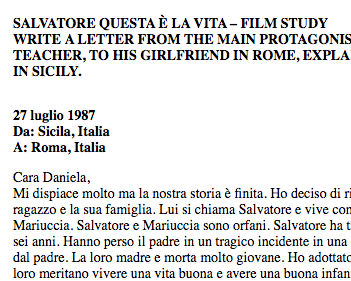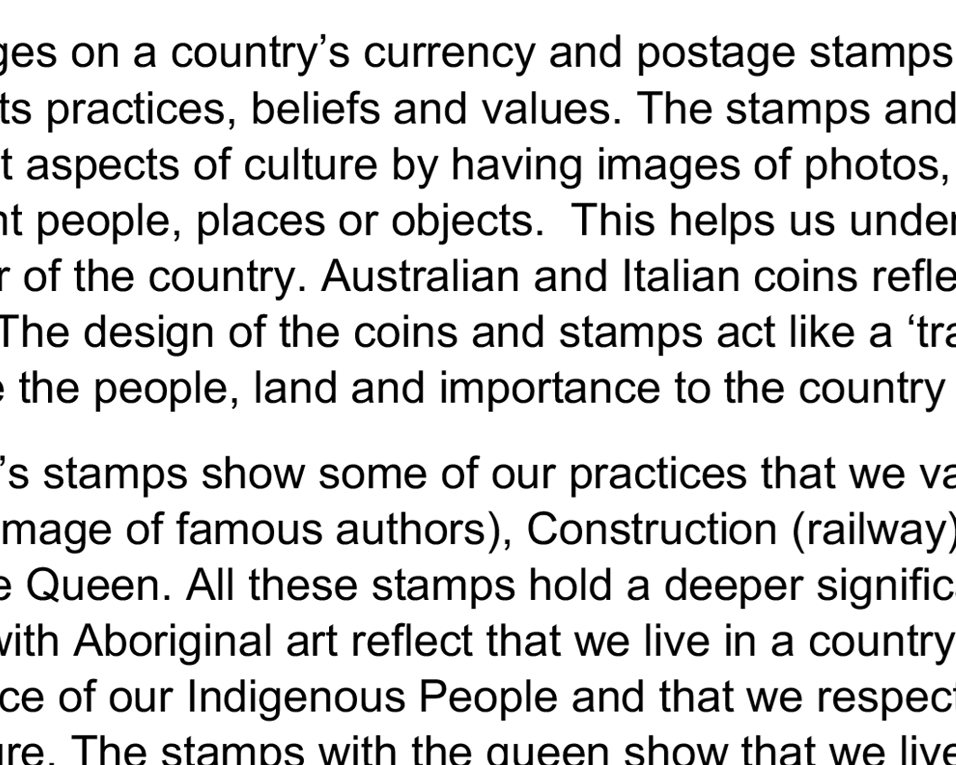Languages: Italian - Satisfactory - Years 9 and 10 (Year 7 entry)
Portfolio summary
This portfolio of student work shows that the student uses a range of everyday language both orally and in writing (WS1, WS2, WS3, WS4, WS5, WS6) to exchange information about their personal, social and local world (WS4, WS6) and about broader issues of personal significance (WS1, WS2, WS3, WS5, WS6). The student communicates thoughts and opinions (WS1, WS2, WS3, WS5, WS6); makes comparisons and contrasts (WS2, WS3, WS5, WS6) (for example, a differenza di; invece), and offers reasons for points of view, opinions (WS1, WS3) and preferences (WS2, WS3, WS6). The student expresses desires and plans for the future (WS1, WS2). The student gives presentations (WS5), and formulates and responds to a range of questions. The student interprets information and attitudes in a range of informational and imaginative texts (WS1, WS2, WS7). The student creates written texts such as descriptions (WS4, WS5, WS6), narratives and recounts that convey experiences, ideas and emotions (WS1, WS2, WS3, WS6). The student gives detailed descriptions (WS2, WS3, WS4, WS5, WS6); describes and relates episodes in time (WS1, WS2, WS6) (for example, prima … poi … infine); and qualifies statements, for example, through the use of relative clauses (WS3, WS6). The student uses simple subject–verb–object constructions (WS1, WS2, WS3, WS4, WS5, WS6), extending or qualifying message by, for example, adding complements or using modal verbs (WS1, WS2) or comparatives (WS3). The student produces bilingual texts, plans what needs to be communicated to particular audiences (WS1, WS4, WS5) and considers different perspectives (WS1, WS2, WS6).
The student uses metalanguage to analyse and discuss features of language choice and use and cultural practice (WS7). The student analyses texts, identifying features such as tone, sequences and relationships of events in time (WS1, WS2). The student communicates their thoughts with awareness of different perspectives on issues or practices being discussed (WS1, WS2, WS3, WS6, WS7). The student explains how Italian language use varies according to context, purpose and mode (WS4, WS5, WS6). The student identifies social and cultural practices of Italians in Italy (WS1, WS3, WS7) and in the diaspora, including communities in Australia (WS3, WS7). The student identifies particular issues relating to translating between Italian and English, such as words with similar meanings and false friends, and identifies certain concepts that cannot be translated readily from Italian to English and from English into Italian. The student reflects on ways in which language and culture together create meanings, and on ways in which their own linguistic and cultural assumptions come into play in using and learning Italian (WS7). The student demonstrates understanding of the role of language and culture in shaping experience, and the ways in which his/her own past experiences shape identity (WS7).






